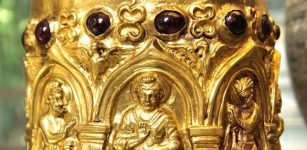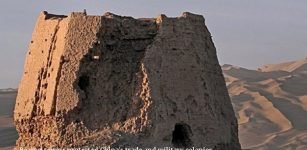Cupbearer Was Privy To Conversations And Political Secrets Hidden Behind Closed Doors
A. Sutherland - AncientPages.com - The role of the cupbearer goes back many thousands of years, and many prominent figures held it.
The cupbearer was a trusted person at the royal courts and in the nobles' and princes' households. His duty was to supervise, pour, and serve the drinks at the royal table.
 Nehemiah served as the king's cupbearer (Nehemiah 1:11), which gave him countless possibilities to speak to the king and request favors from him. Image source
Nehemiah served as the king's cupbearer (Nehemiah 1:11), which gave him countless possibilities to speak to the king and request favors from him. Image source
The chosen cupbearer was usually a high-ranked and noble person of the royal court. Usually, he was also influential, wealthy, and the ruler trusted him, often showing gratitude.
He was with the ruler at all times, and his primary duty was to taste the wine served to the king as a precaution against poisoning. The king could rely on his loyalty and trust him.
In old times, monarchs were paranoid about attempted assassinations, but not without reason. Due to the constant fear of conspiracies and intrigue, the king's cupbearer must be completely reliable. As poisoning was very often a way to get rid of a king or another important figure, the cupbearer's most serious responsibility was to protect his master, family members, and guests at the table.
Secret Conversations Behind Closed Doors
He had to make sure that no one had tampered with drinks and food. The cupbearer would also pour wine or other drinks to honored guests present at the table. It would make him privy to many conversations taking place at the table and political secrets that were always hidden behind closed doors.
In many cases, the threat of poisoning was often real. The cupbearer's high-risk job was not only vital but also dangerous and full of responsibility because he was also a security officer to protect him against assassination.
 Bas-Relief From Persepolis, Ancient Persia). It shows Darius I, the Great, sitting on the throne, and he is followed by his son, Xerxes, the Crown Prince. Nehemiah - the Chief Cupbearer, is standing behind Xerxes. Credit: Public Domain
Bas-Relief From Persepolis, Ancient Persia). It shows Darius I, the Great, sitting on the throne, and he is followed by his son, Xerxes, the Crown Prince. Nehemiah - the Chief Cupbearer, is standing behind Xerxes. Credit: Public Domain
He daily placed his own life at risk, which made his profession extremely dangerous.
The Cupbearer Was A Trusted Advisor
The cupbearer was the king's trusted advisor and the one who was expected to give honest advice behind closed doors. Being almost always in the king's presence, the cupbearer listened to many private and often secret information. Therefore, he was required to be trustworthy and able to keep the confidence.
Having his master's affection and trust, the cupbearer could change his career path by getting a position with significant influence.
There were many prominent, wealthy, and trusted cupbearers in Sumer, Egypt, where foreigners held the position as cupbearers, Assyria, Canaan, Persia, Poland, Sweden, and other royal courts.
In Mesopotamia, the job of a cupbearer was highly respected. Kings had assigned cupbearers, who were trusty members of the royal court responsible for overseeing all the dining activities. Cupbearers' work was not only limited to kings but also government workers.
 Persian, Achaemenid, Persepolis, Iran, 486–465 B.C., Cupbearer, relief from the Palace of Xerxes I. source
Persian, Achaemenid, Persepolis, Iran, 486–465 B.C., Cupbearer, relief from the Palace of Xerxes I. source
One of the most famous personalities of the ancient world was Sargon of Akkad, who was the cupbearer for Ur-Zababa of Kish. As many of us probably know, he would later take the throne as the first emperor of the Akkadian Empire in 2334 BC, and his great empire flourished about two centuries before it finally ended around 2,100 B.C.
Another cupbearer was Nehemiah, a high official in the Persian court of King Artaxerxes I at Susa's capital city in what is now modern Iran.
Nehemiah wanted so much to return to Jerusalem to rebuild Jerusalem's walls. So e did, but before it happened, he served as the king's cupbearer (Nehemiah 1:11), which gave him countless possibilities to speak to the king and request favors from him.
Herodotus described the royal cupbearer's office in Persia as a great honor "of very particular distinction."
Also, an Athenian historian, philosopher, and soldier, Xenophon (c.430 BC – 354 BC), described a cupbearer's duties in the royal court of the Medes. According to his description, the cupbearer was "handsome" and had the role of presenting certain persons to the king and keeping others out. He poured and served the wine to the king with great skill, tasting it first to guard against poisoning.
Written by – A. Sutherland - AncientPages.com Senior Staff Writer
Updated on January 31, 2024
Copyright © AncientPages.com All rights reserved. This material may not be published, broadcast, rewritten or redistributed in whole or part without the express written permission of AncientPages.com
Expand for referencesReferences:
O F Walton, The King's Cup-Bearer
Princeton University Art Museum
Herodotus, The Histories, John M. Marincola, et al.
More From Ancient Pages
-
 The Bimaran Casket – Rare Golden Artifact Found In Ancient Stupa
Artifacts | Dec 17, 2018
The Bimaran Casket – Rare Golden Artifact Found In Ancient Stupa
Artifacts | Dec 17, 2018 -
 First European Farmers’ Heights Did Not Meet Expectations
Archaeology | Apr 8, 2022
First European Farmers’ Heights Did Not Meet Expectations
Archaeology | Apr 8, 2022 -
 Pyramid Of Djoser May Have Been Constructed Using Hydraulic Lift Technology – Scientists Say
Archaeology | Aug 5, 2024
Pyramid Of Djoser May Have Been Constructed Using Hydraulic Lift Technology – Scientists Say
Archaeology | Aug 5, 2024 -
 Why Has The Leaning Tower Of Pisa Survived Strong Earthquakes Since The Middle Ages?
Archaeology | May 10, 2018
Why Has The Leaning Tower Of Pisa Survived Strong Earthquakes Since The Middle Ages?
Archaeology | May 10, 2018 -
 Posca: ‘Wine Of The People’ Was Popular In Ancient Rome And Greece
Ancient History Facts | Sep 26, 2018
Posca: ‘Wine Of The People’ Was Popular In Ancient Rome And Greece
Ancient History Facts | Sep 26, 2018 -
 Keshwa Chaca – Last Suspension Rope Bridge Of Inca People
Ancient Traditions And Customs | Apr 17, 2019
Keshwa Chaca – Last Suspension Rope Bridge Of Inca People
Ancient Traditions And Customs | Apr 17, 2019 -
 New Study Shows How The Ancient World Adapted To Climate Change
Archaeology | Jun 28, 2022
New Study Shows How The Ancient World Adapted To Climate Change
Archaeology | Jun 28, 2022 -
 People Have Two Souls – Native American And Pre-Christian Beliefs Reveal
Featured Stories | Apr 8, 2020
People Have Two Souls – Native American And Pre-Christian Beliefs Reveal
Featured Stories | Apr 8, 2020 -
 Florentine Codex: Remarkable Manuscripts About Life Of The Aztecs
Ancient History Facts | Nov 15, 2016
Florentine Codex: Remarkable Manuscripts About Life Of The Aztecs
Ancient History Facts | Nov 15, 2016 -
 On This Day In History: Storming Of The Paris Fortress – Prison Bastille – On July 14, 1789
News | Jul 14, 2016
On This Day In History: Storming Of The Paris Fortress – Prison Bastille – On July 14, 1789
News | Jul 14, 2016 -
 Garamantes: 3,000-Year-Old Sophisticated North African Society Built 3,000-Mile Network Of Underground Irrigation Canals
Featured Stories | Jan 29, 2022
Garamantes: 3,000-Year-Old Sophisticated North African Society Built 3,000-Mile Network Of Underground Irrigation Canals
Featured Stories | Jan 29, 2022 -
 Paleolithic Cave Dwellers And Light They Could Get In Darkness
Archaeology | Jun 21, 2021
Paleolithic Cave Dwellers And Light They Could Get In Darkness
Archaeology | Jun 21, 2021 -
 Mounds In Louisiana, North America Offer Insight Into Middle Archaic Lifestyles
Archaeology | Dec 2, 2022
Mounds In Louisiana, North America Offer Insight Into Middle Archaic Lifestyles
Archaeology | Dec 2, 2022 -
 Mystery Of Panxian Cave: How Could Gigantic Animals Reach A Mountain Cave Located Over 1600m Above Sea Level?
Featured Stories | Jul 1, 2014
Mystery Of Panxian Cave: How Could Gigantic Animals Reach A Mountain Cave Located Over 1600m Above Sea Level?
Featured Stories | Jul 1, 2014 -
 On This Day In History: ‘Battle On The Ice’ – Army Of Prince Nevsky Against Teutonic Knights Was Fought – On Apr 5, 1242
News | Apr 5, 2016
On This Day In History: ‘Battle On The Ice’ – Army Of Prince Nevsky Against Teutonic Knights Was Fought – On Apr 5, 1242
News | Apr 5, 2016 -
 Nine Great Wall Beacon Towers Discovered In China’s Inner Mongolia
Archaeology | Apr 21, 2020
Nine Great Wall Beacon Towers Discovered In China’s Inner Mongolia
Archaeology | Apr 21, 2020 -
 How The Strange Dream Of Roman Emperor Constantine Changed History
Ancient History Facts | Sep 29, 2017
How The Strange Dream Of Roman Emperor Constantine Changed History
Ancient History Facts | Sep 29, 2017 -
 Pyramid Of Unknown Ancient Egyptian Queen And Hundreds Of Mummies Discovered In Saqqara
Archaeology | Nov 17, 2022
Pyramid Of Unknown Ancient Egyptian Queen And Hundreds Of Mummies Discovered In Saqqara
Archaeology | Nov 17, 2022 -
 Collapse Of Ancient Mayan Capital Linked To Drought – New Study Suggests
Archaeology | Aug 20, 2022
Collapse Of Ancient Mayan Capital Linked To Drought – New Study Suggests
Archaeology | Aug 20, 2022 -
 Fascinating Ancient Legend Of Jason And His Argonauts Was Based On A Real Expedition To An Ancient Kingdom
Greek Mythology | Dec 3, 2014
Fascinating Ancient Legend Of Jason And His Argonauts Was Based On A Real Expedition To An Ancient Kingdom
Greek Mythology | Dec 3, 2014
